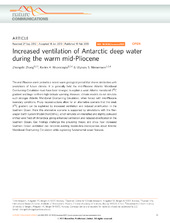Increased ventilation of Antarctic deep water during the warm mid-Pliocene
Peer reviewed, Journal article
Published version

Åpne
Permanent lenke
https://hdl.handle.net/1956/12376Utgivelsesdato
2013-02-19Metadata
Vis full innførselSamlinger
- Department of Earth Science [1050]
Originalversjon
https://doi.org/10.1038/ncomms2521Sammendrag
The mid-Pliocene warm period is a recent warm geological period that shares similarities with predictions of future climate. It is generally held the mid-Pliocene Atlantic Meridional Overturning Circulation must have been stronger, to explain a weak Atlantic meridional δ13C gradient and large northern high-latitude warming. However, climate models do not simulate such stronger Atlantic Meridional Overturning Circulation, when forced with mid-Pliocene boundary conditions. Proxy reconstructions allow for an alternative scenario that the weak δ13C gradient can be explained by increased ventilation and reduced stratification in the Southern Ocean. Here this alternative scenario is supported by simulations with the Norwegian Earth System Model (NorESM-L), which simulate an intensified and slightly poleward shifted wind field off Antarctica, giving enhanced ventilation and reduced stratification in the Southern Ocean. Our findings challenge the prevailing theory and show how increased Southern Ocean ventilation can reconcile existing model-data discrepancies about Atlantic Meridional Overturning Circulation while explaining fundamental ocean features.
